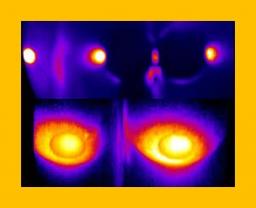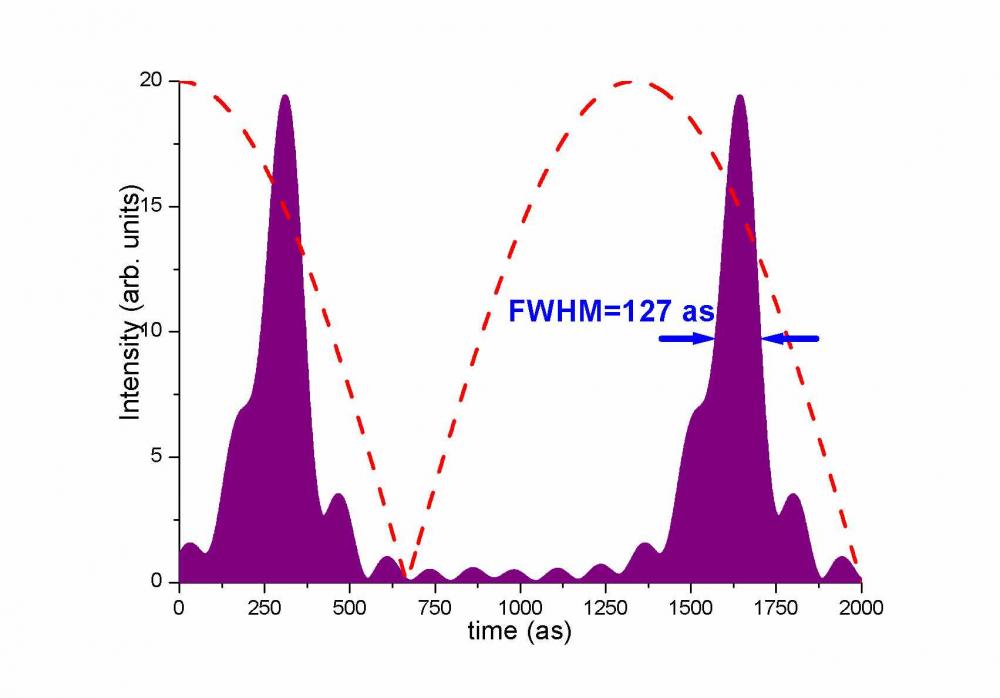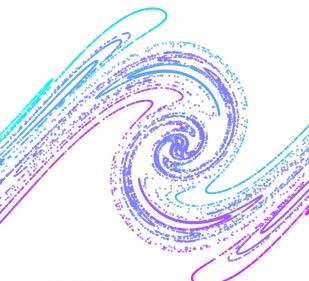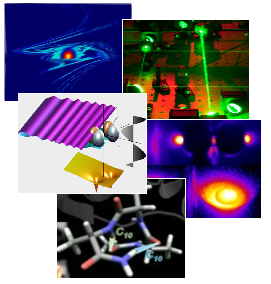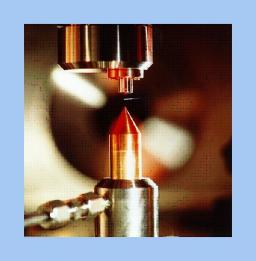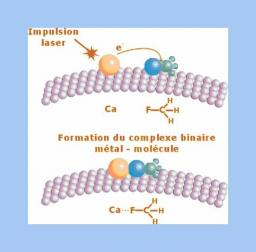 Laser-matter interaction
Laser-matter interactionIRAMIS's research activities on laser-matter interaction concern both physical and chemical matters. Research programs range from simple atomic and molecular systems, to complex molecular and biomolecular systems, up to solids and plasmas.
IRAMIS is an important player in the "laser Pole" of the University Paris Saclay: it coordinates the ATTOLAB facility, aimed at interdisciplinary study of ultrafast dynamics at femtosecond and attosecond time scales, in systems vapor, condensed matter and plasma. It also hosts the Interdisciplinary Center for Extreme Light (Equipex CILEX, including the APOLLO 10 PW laser), for the study of material behavior in the unexplored ultra-relativistic interaction regime.
While the pulse durations of infrared lasers are reaching the fundamental limitation imposed by the duration of the optical cycle (a few femtoseconds), High-order Harmonic Generation has recently opened a new field by accessing the attosecond regime (1as = 10-18 s).
HHG spectra are made of lines corresponding to the odd multiples of the fundamental laser frequency, and can cover a very broad spectral range, from visible light to soft X-rays. If these harmonics are phase locked, then the corresponding temporal profile is a train of attosecond pulses separated by half the laser period, whose duration decreases as the number of combined harmonics increases. The first experimental demonstration of attosecond pulses was performed in 2001 by the attophysics group in collaboration with the Laboratoire d’Optique Appliquée (Palaiseau) and FOM institute (The Netherlands) using the RABBITT technique [1]. We measured a train of 250 as pulses, corresponding to the superposition of five consecutive harmonics. In 2003 we extended this study by measuring the relative phases of the high harmonics over a broad spectral range [2]. This uncovered for the first time the presence of an intrinsic chirp of the attosecond emission.
Currently our activity is aiming at further developing these attosecond sources and at exploring the new physics they make accessible (see below). In-house theoretical studies provide support on these topics, using and developing 3D propagation codes in combination with Strong Field Approximation microscopic response. Further support is provided through external collaborations with theoretical groups in, e.g. Paris (LCPMR), or Madrid (UAM).
[1] P.-M. Paul et al., Observation of a train of attosecond pulses from high harmonic generation, Science, 292, 1689 (2001).
[2] Y. Mairesse et al. Attosecond synchronization of high-harmonic soft X-rays, Science, 302, 1540 (2003)
Au LIDYL, les simulations numériques permettent de modéliser l'interaction de la lumière avec la matière en particulier sous l'effet d'impulsions laser de très haute intensité et extrêmement brèves (domaine attoseconde (10-18 s). Les simulations de plasma denses ou dilués, en particulier à la surface d'un solide, ou encore l'interaction de plusieurs impulsions successives (miroir plasma) demandent des réaliser des calculs intensifs ultrapuissants, sur des machines pouvant effectuer des milliards de calculs par seconde.
Cette thématique couvre les activités suivantes au sein du LIDYL :
- Calcul exascale
- Développement algorithmique et modélisation
- Frugalité numérique
- Intelligence artificielle
La matière sous toutes ses formes est quantifiée. Atomes, molécules des molécules simples aux macromolécules biologiques, présentent des spectres lumineux caractéristiques, en absorption ou en émission, que l'on peut identifier par spectroscopie. Les sources lasers et plus particulièrement les sources impulsionnelles permettent aujourd'hui de nouveaux développements de tous les types de spectroscopies.
C'est par ces techniques que plusieurs équipes du LIDYL abordent des sujets de recherche très actuels :
- Caractérisation de produits de fission
- Dosimétrie par fluorescence
- Nouvelles approches pour la radiothérapie (Radiothérapie 2.0)
- Physico-chimie multi-échelle de la radiolyse
The MEC laboratory is a fundamental research lab where two closely related topics are investigated, on the one hand the interaction of matter with a strong laser field, i.e., at high power density, on the other hand the matter at very high energy density, i.e., hot dense plasmas. The MEC lab is composed of 3 interacting research groups, namely Attophysics, Physics at High Intensity (PHI), and High Energy Density Matter (HEDM). The MEC lab comprises 19 permanent scientists and about 15 post-doctorate, PhD and graduate students.
In a strong laser field, corresponding to laser intensity in the range 1014-1019 W/cm2, electrons in atoms, molecules or solids can very efficiently exchange energy with the field or the laser-produced plasma. This efficient field-electron coupling leads to a variety of processes which are investigated in the Attophysics and Physics at High Intensity groups. They mainly develop their experimental programs on the laser facilities of the Saclay Laser-matter Interaction Centre ( SLIC ), partner of the Laserlab-Europe consortium. Facilities include LUCA, PLFA and UHI100 state-of-the-art laser systems.
In the Attophysics group, we study the very rich dynamics of electrons initially bound in atoms and molecules, under strong laser field irradiation (intensity 1014-1015 W/cm2). This dynamics takes place at the ultra-short time scale of one or a few optical cycles, e.g., 2.7 femtosecond at 800 nm wavelength. It governs the multiple ionization and fragmentation of the system, e.g., molecules, the diffraction of electrons, or the spectacular emission of ultra-short light pulses – of typically 100 attoseconds duration – in the extreme-UV range (l = 1 - 100 nm). Such pulses can be used to probe the fastest processes in matter. Moreover, the inelastic scattering of electrons accelerated in a laser field constitutes a very powerful probe of the system itself and of its ultra-fast dynamics, e.g., molecular fragmentation. The probe can combine extreme spatial resolution at the angstrom scale and temporal resolution at the attosecond scale, opening the perspective of following chemical reactions in real time. The Attophysics group develops as well applications of the ultra-short light pulses in the extreme-UV to dynamical studies.
In the Physics at High Intensity group, we study the so-called “ultra- relativistic regime”. To study these new frontiers, occurring upon reflection on overdense plasmas, it is essential to use extremely high temporal-contrast lasers. This opens the way to detailed studies of relativistic plasma optics in well-controlled conditions.
The first topic exploits the extreme nonlinearities induced by the ultra-strong laser fields upon reflection on a plasma, a medium capable of withstanding arbitrarily high laser intensities, in order to efficiently generate trains of energetic attosecond pulses in the XUV domain and isolated attosecond pulses in the UV range.
The second topic is based on ions-laser-acceleration processes. We focus on the fine understanding of various parameters influence such as gradient scale length, laser intensity and polarization and their impact on the ionic acceleration. Special efforts are paid to bring the ion energy and charge toward their maximum limits. This supports a large panel of applications of societal relevance, from the production and diagnosis of dense plasmas to the proton therapy.
The last topic is devoted to the electron acceleration using under-critical (gaseous) targets. Extremely promising laser acceleration of electrons has now been demonstrated up to energy in the GeV range. This concept should decisively contribute to, for example, radiolysis studies at ultra-short time scale, or reducing the dimensions of accelerator-based light sources to the lab scale.
The High Energy Density Matter group studies the atomic physics in hot dense plasmas, i.e., their electronic and radiative properties such as emissivity, opacity, or equation of state. Matter at high energy density appears naturally in most of the astrophysical objects – stars, supernovae -, as well as in laser-produced hot dense plasmas relevant for Inertial Confinement Fusion (ICF). The theory is developed in close connection to experiments at large scale laser facilities, e.g., the LIL (Ligne d’Intégration Laser) and LMJ (Laser MégaJoule), and Z-pinch sources (Sandia).
Plasmas: Understanding the properties of dense and hot plasmas is important for CEA. Lasers make it possible to create and probe plasmas.
A chemical reaction depends not only of atoms and molecules involved but also of their short range environment. Understanding a chemical reaction demands a fundamental approach taking into account both temporal and spatial features.
Therefore, IRAMIS implements with lasers, time-resolved spectroscopies in the range from femtosecond to the millisecond, to study the dynamics of molecular systems, like for example DNA biomolecules, or chromophore molecules for photovoltaics. The various conformations adopted by the biomolecules by virtue of their flexibility are studied by a dual experience - theory approach, with quantum chemical simulations. More complex systems that are out of equilibrium, including isolated gas phase or molecular systems bound to aggregates, are also studied in order to identify and model the forces that drive their reaction dynamics.









